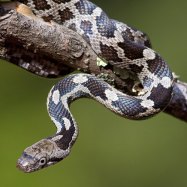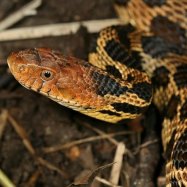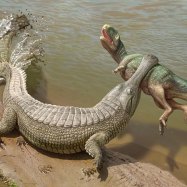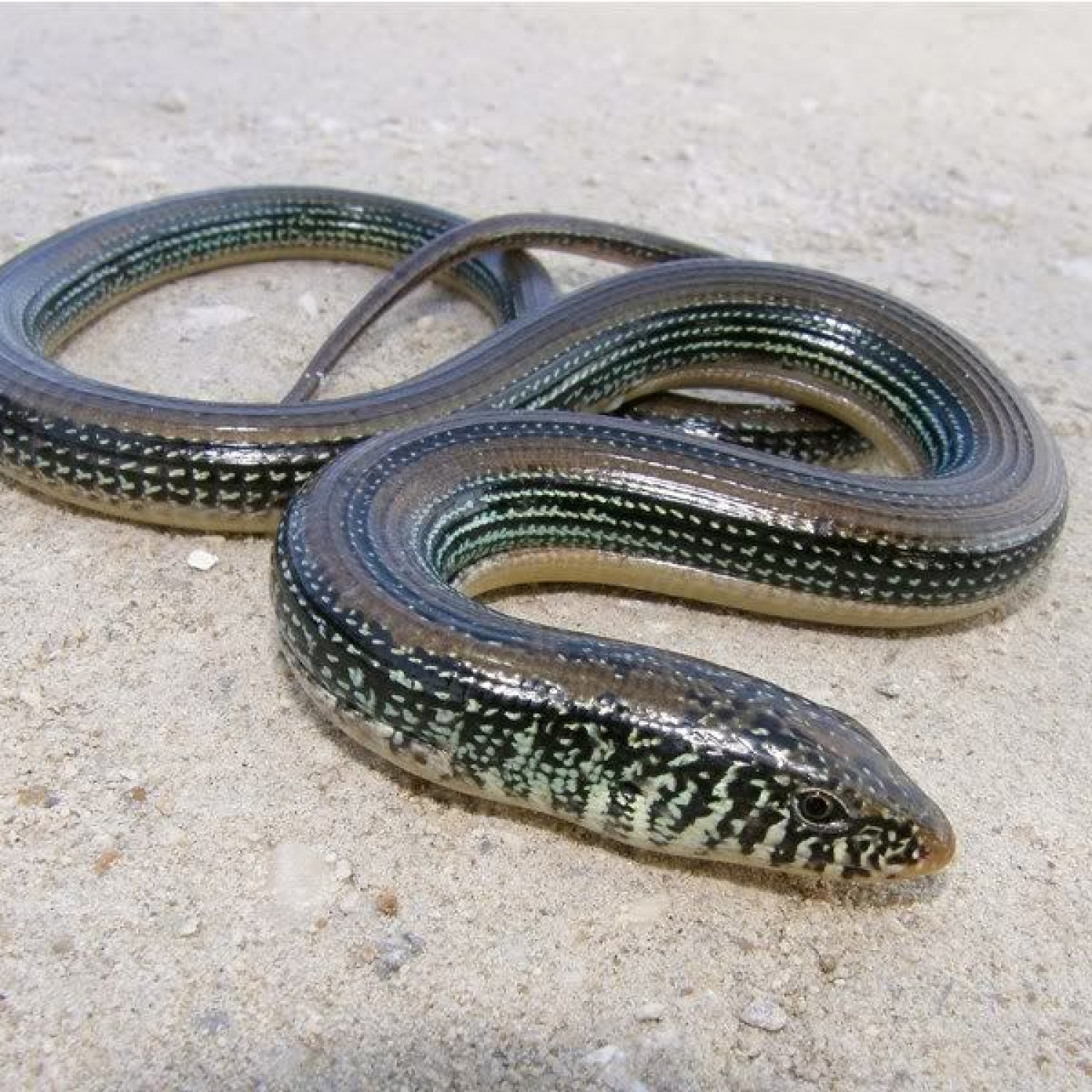
Eastern Glass Lizard
Up to 4 feet (1.2 meters)
Meet the Eastern Glass Lizard, a unique reptile found in the southeastern United States. With a long and slender body, these lizards can grow up to 4 feet in length, resembling a snake. They are found in Florida, Georgia, Alabama, and South Carolina and belong to the Anguidae family. Keep your eyes open on your next hike in these states for a chance to spot this fascinating creature!
Animal Details Summary:
Common Name: Eastern Glass Lizard
Kingdom: Animalia
Habitat: Grasslands, savannas, forests
The Elusive Eastern Glass Lizard: A Closer Look at the Fascinating Reptile
Hidden among the grasslands, savannas, and forests of the eastern United States lies a fascinating creature – the Eastern Glass Lizard. Often mistaken for a snake due to its long and slender body, this reptile is, in fact, a lizard. With its unique characteristics and elusive nature, the Eastern Glass Lizard stands out among its reptile counterparts. In this article, we will delve deeper into the world of the Eastern Glass Lizard and uncover its intriguing features, from its scientific classification to its habitat, feeding behavior, and more Eastern Glass Lizard.Classified: The Scientific Name of the Eastern Glass Lizard
The Eastern Glass Lizard, also known as Ophisaurus ventralis, belongs to the kingdom Animalia and phylum Chordata. Within the class Reptilia, it falls under the order Squamata and the family Anguidae. This classification may sound scientific and technical, but it simply means that the Eastern Glass Lizard is an animal with a backbone and scales, and it is related to snakes and lizards.Origin and Geographical Distribution
The Eastern Glass Lizard is native to the United States, specifically the eastern region. Its natural habitat can be found in the states of Florida, Georgia, Alabama, and South Carolina. However, due to its elusiveness and secretive nature, not much is known about its geographical distribution. The Eastern Glass Lizard is a master of camouflage, making it challenging to spot in its natural habitat. Its coloring and body shape allow it to blend seamlessly with its surroundings.Appearance and Body Structure
The Eastern Glass Lizard has a distinct appearance that sets it apart from other lizards Eurypterus. Its body can grow up to 4 feet (1.2 meters) in length, making it one of the largest lizards in North America. Its long and slender body, measuring about a quarter of its overall length, is covered with small, shiny scales. These scales give the Eastern Glass Lizard its unique glass-like appearance, hence its name.Another unique feature of this reptile is its tail. Unlike other lizard species, the Eastern Glass Lizard has a breakable tail that can detach when under attack. This serves as a defense mechanism, allowing the lizard to escape from predators. The detached tail may continue to wriggle, acting as a decoy to distract the predator while the lizard makes its getaway.
The Colorful World of the Eastern Glass Lizard
The Eastern Glass Lizard's coloration is not as distinct as its physical features. Its overall color can vary from light brown to gray, and its belly may have a yellow or white hue. However, its coloring can change according to its surroundings, allowing it to remain undetected in its habitat. This ability to adapt to its environment is a crucial survival technique for the Eastern Glass Lizard.Habitat and Feeding Behavior
The Eastern Glass Lizard prefers to dwell in grasslands, savannas, and forests, where it can blend in with its surroundings. It is a solitary creature and rarely seen in groups. It is also a diurnal reptile, meaning it is active during the day.As a carnivorous species, the Eastern Glass Lizard feeds on a variety of prey, including insects, snails, small reptiles, rodents, and birds. Its sharp teeth enable it to grasp and consume its prey quickly, and its long body allows it to move swiftly and catch prey with ease. Its diet also includes eggs and carrion, making it a vital part of the ecosystem.
The Eastern Glass Lizard and Humans
The Eastern Glass Lizard may not be as well-known as other lizard species, but it plays a crucial role in maintaining the balance of its ecosystem. Due to its elusive nature, it has not been heavily studied, and its conservation status is currently unknown. However, it is believed to face threats such as habitat destruction and human interference in its natural habitat.As with other wild animals, it is important to respect and admire the Eastern Glass Lizard from a distance and not disturb its habitat. As humans, we have a responsibility to protect and preserve the delicate balance of nature and appreciate the diversity of all creatures, no matter how small or seemingly insignificant.
The Fascinating World of Reptiles
The Eastern Glass Lizard is just one of the many intriguing reptiles that inhabit our planet. Reptiles make up a significant portion of the world's animal population, with over 10,000 species currently identified. From snakes and lizards to turtles and crocodiles, these cold-blooded creatures have adapted to various environments and play essential roles in their respective ecosystems.Aside from their diversity, reptiles also exhibit unique characteristics that set them apart from other animals. For example, some species can camouflage themselves to blend in with their surroundings, while others use their brightly colored scales or patterns as a defense mechanism. The Eastern Glass Lizard, with its glass-like scales and breakable tail, is a prime example of this.
Natural Language Processing and its Role in Studying Reptiles
With the increasing use of Natural Language Processing (NLP) in data analysis, the study of reptiles has taken a new form. NLP allows scientists to analyze vast amounts of data and identify patterns in animal behaviors, such as feeding and habitat preferences. By understanding these patterns, researchers can gain valuable insights into the lives of these elusive creatures and aid conservation efforts.Furthermore, NLP is also used in identifying and classifying different reptile species. With hundreds of newly discovered species each year, NLP plays a critical role in helping scientists accurately identify and classify these animals based on their physical characteristics and behavior.
Conclusion
In conclusion, the Eastern Glass Lizard is an elusive and intriguing reptile that adds to the diverse world of reptiles. Its glass-like appearance and breakable tail make it stand out among its counterparts, and its ability to adapt to its surroundings makes it a master of camouflage. As with all animals, it is crucial to respect the Eastern Glass Lizard and appreciate its role in maintaining the balance of nature. With advancements in technology, we can continue to uncover the mysteries of this elusive creature and gain a deeper understanding of its unique characteristics.

Eastern Glass Lizard
Animal Details Eastern Glass Lizard - Scientific Name: Ophisaurus ventralis
- Category: Animals E
- Scientific Name: Ophisaurus ventralis
- Common Name: Eastern Glass Lizard
- Kingdom: Animalia
- Phylum: Chordata
- Class: Reptilia
- Order: Squamata
- Family: Anguidae
- Habitat: Grasslands, savannas, forests
- Feeding Method: Carnivorous
- Geographical Distribution: Eastern United States
- Country of Origin: United States
- Location: Florida, Georgia, Alabama, South Carolina
- Animal Coloration: Varies, typically brown or gray with a yellow or white belly
- Body Shape: Long and slender, resembling a snake
- Length: Up to 4 feet (1.2 meters)
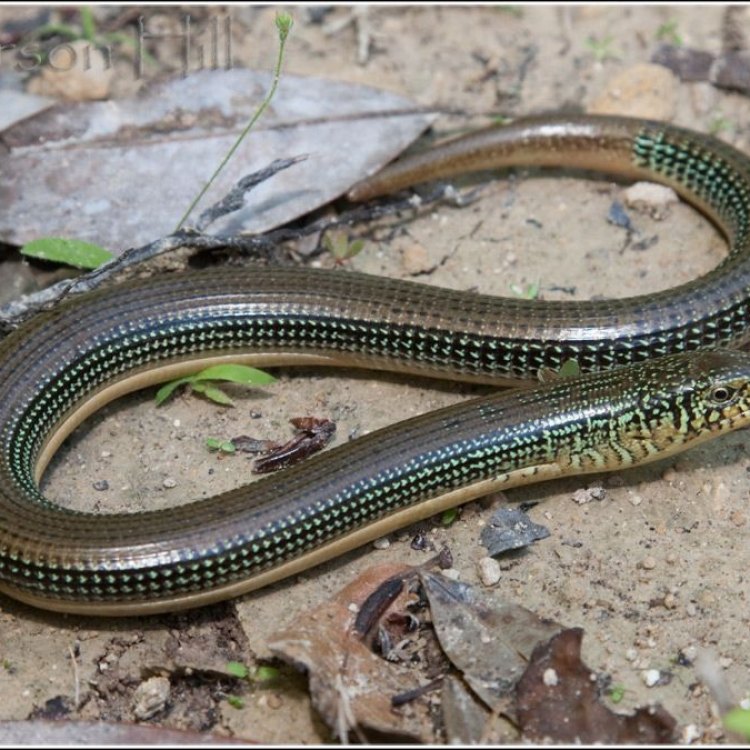
Eastern Glass Lizard
- Adult Size: Large
- Average Lifespan: 10-15 years
- Reproduction: Oviparous (lays eggs)
- Reproductive Behavior: Mating in spring
- Sound or Call: No vocal cords
- Migration Pattern: Non-migratory
- Social Groups: Solitary
- Behavior: Diurnal (active during the day)
- Threats: Habitat destruction, road mortality, collection for pet trade
- Conservation Status: Least Concern
- Impact on Ecosystem: Preys on small animals, maintains population balance
- Human Use: Occasionally kept as pets
- Distinctive Features: Lizard-like appearance, long and fragile tail
- Interesting Facts: Eastern Glass Lizards can shed their tail as a defense mechanism, which will later regenerate.
- Predator: Birds of prey, snakes, mammals
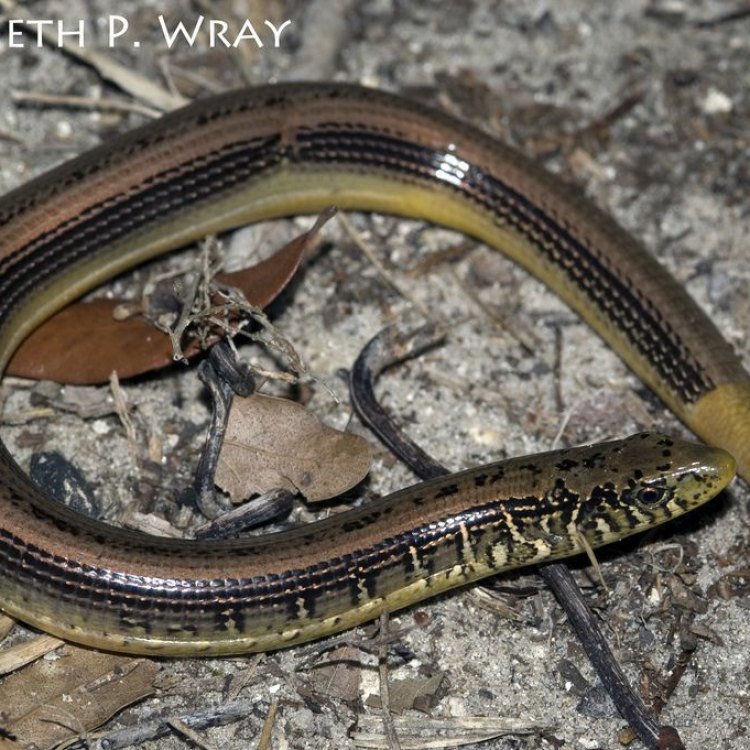
Ophisaurus ventralis
An Intriguing Look at the Eastern Glass Lizard: The Lizard That Looks Like a Snake
Imagine walking through a wooded area and suddenly coming upon a lizard that looks like a snake. You may do a double-take, questioning if what you're seeing is really a lizard or a cleverly disguised snake. This is the Eastern Glass Lizard, also known as the Glass Snake, a unique reptile that has adapted to mimic the appearance and behavior of a snake. In this article, we will take an in-depth look at this fascinating creature, exploring its distinctive features, behavior, and impact on the ecosystem PeaceOfAnimals.Com.The Eastern Glass Lizard, scientifically known as Ophisaurus ventralis, is a large lizard found in the eastern United States. They are typically found in forests, fields, and grasslands, preferring areas with loose soil for burrowing. This non-venomous reptile is often mistaken for a snake due to its long, slender body and lack of legs. However, upon closer inspection, one can see that it has a pair of tiny front legs and a pair of hind legs, although they are not functional for movement. This unique evolutionary trait is what gives this lizard its distinctive "glass-like" appearance.
Adult Eastern Glass Lizards can reach an impressive size of up to 3 feet in length, with most individuals averaging around 2 feet. They have an average lifespan of 10-15 years in the wild, and they are known for their remarkable ability to shed and regenerate their tails. This is a common defense mechanism in many lizard species, but the Eastern Glass Lizard takes it to another level. Not only do they shed their tails, but the regrown tail also has a strikingly different appearance, resembling the tail of a young lizard with its bright blue coloring Earless Monitor Lizard.
One of the most unique reproductive behaviors of the Eastern Glass Lizard is its method of reproduction. Like most lizards, they are oviparous, meaning they lay eggs. However, what sets them apart is their breeding season, which occurs in the spring. During this time, male lizards will engage in combat to win the right to mate with a female. This is primarily done through biting and pushing, and it can be quite brutal to watch. Once the male has won, the pair will mate, and the female will go on to lay her eggs in a burrow. Interestingly, Eastern Glass Lizards also demonstrate a behavior known as "alternate copulation," where two males will mate with a single female at the same time.
Eastern Glass Lizards are diurnal creatures, meaning they are active during the day. They spend most of their time basking in the sun and foraging for food. As they do not have vocal cords, they are unable to make any sounds or calls, making them a silent species. They are solitary animals, only coming into contact with other lizards during the breeding season.
So, what do Eastern Glass Lizards eat? As predators, they primarily feed on small animals such as insects, snails, and small mammals. Their diet plays an essential role in maintaining the balance of their ecosystem, as they are known to control the population of small animals. This ensures that their prey does not overpopulate, which can have negative effects on the vegetation and other animals in the ecosystem.
Unfortunately, like many other species, Eastern Glass Lizards are facing numerous threats to their survival. Habitat destruction, road mortality, and collection for the pet trade are among the leading causes of their decline. As these lizards require loose soil for burrowing, urbanization and land development have taken a toll on their habitats. Additionally, many are killed each year by cars while crossing roads. Furthermore, they are often collected and sold as pets, despite the fact that they do not thrive in captivity and are difficult to care for properly.
Despite these threats, the Eastern Glass Lizard has been classified as "Least Concern" by the International Union for Conservation of Nature (IUCN). This is due to their widespread distribution and relatively stable population. However, it is essential to continue monitoring their population and addressing the threats they face to ensure their survival for future generations.
The impact of the Eastern Glass Lizard on the ecosystem goes beyond being a predator of small animals. Its unique appearance and behavior have made it a subject of interest for scientists and nature enthusiasts alike. These lizards have also been studied for their regenerative abilities, which have the potential to provide insights for regenerative medicine in humans.
In terms of human use, Eastern Glass Lizards are occasionally kept as pets, although it is not recommended. As mentioned earlier, they do not thrive in captivity and require specialized care to meet their specific needs. Additionally, they are protected under state laws in many states, making it illegal to possess them as pets.
If you ever come across an Eastern Glass Lizard, it is vital to admire it from a distance and not disturb it. They are often mistaken for snakes and may be killed out of fear. It is also essential to follow laws and regulations when encountering this species, as they are necessary for their protection and survival.
In conclusion, the Eastern Glass Lizard is a unique and intriguing reptile that has adapted to mimic a snake's appearance and behavior. From their distinctive glass-like appearance to their fascinating reproductive behavior and regenerative abilities, these lizards are truly a marvel of evolution. However, they also face threats to their survival, making it crucial for us to protect and conserve them for future generations to admire and study. So, the next time you come across an Eastern Glass Lizard, take a moment to appreciate this fascinating creature and its role in our ecosystem.
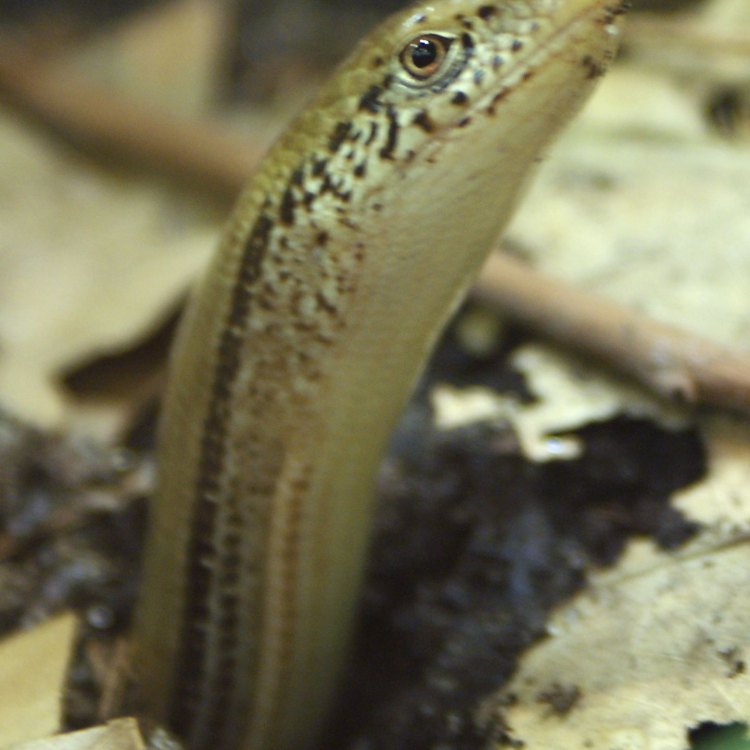
The Elusive Eastern Glass Lizard: A Closer Look at the Fascinating Reptile
Disclaimer: The content provided is for informational purposes only. We cannot guarantee the accuracy of the information on this page 100%. All information provided here may change without prior notice.








